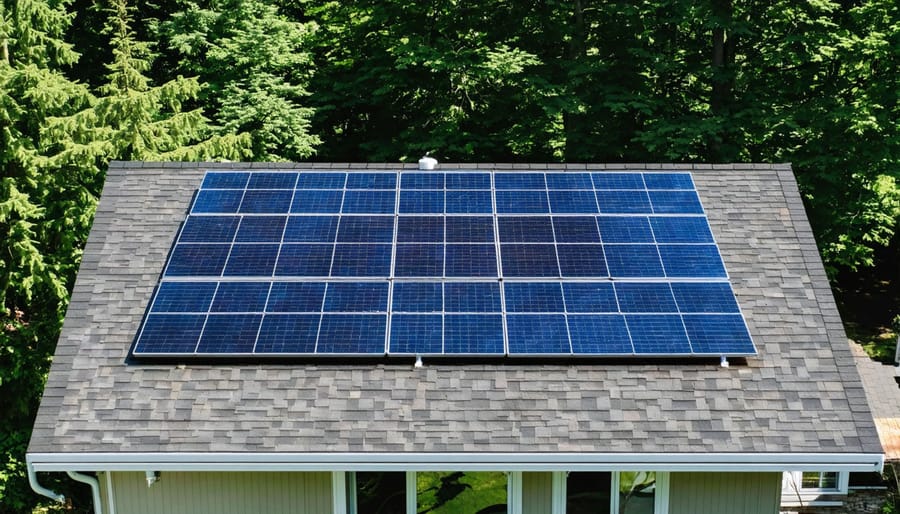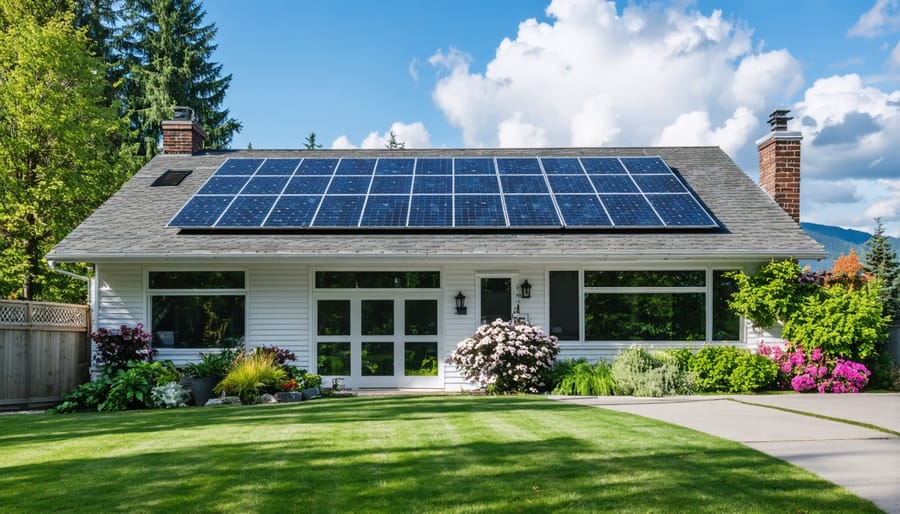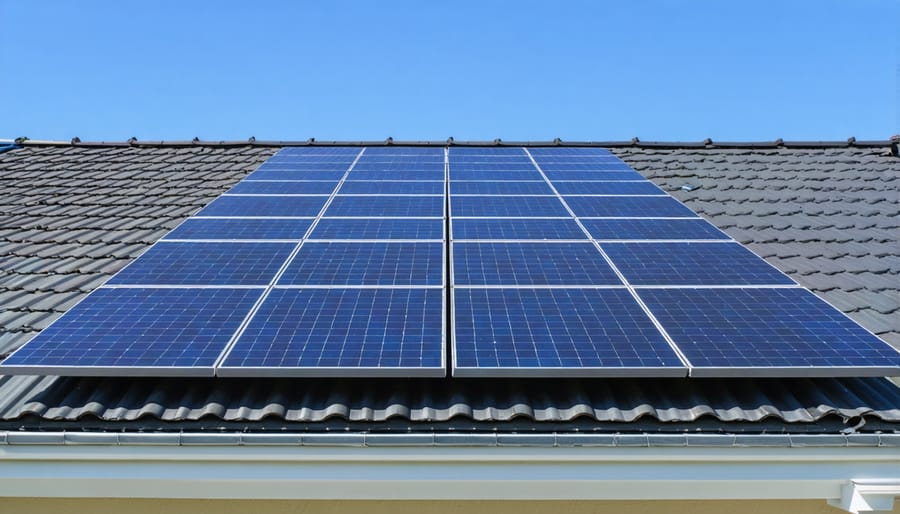Eliminate your upfront solar costs completely through zero-down financing programs now available across British Columbia. You can begin generating your own clean energy without paying thousands upfront by choosing from three proven pathways: solar loans with $0 initial payment, power purchase agreements where you pay only for the electricity produced, or solar leases that let you rent the equipment. Calculate your monthly savings by comparing your current BC Hydro bill against projected solar payments—most homeowners discover they break even or save money from day one while building equity in their system. Lock in your electricity costs for 20-25 years and protect yourself from rising utility rates that have increased 30% over the past decade. Qualify by meeting basic credit requirements, owning your home, and having adequate roof space with southern exposure. The financial reality is straightforward: instead of paying $15,000-$30,000 upfront, you redirect a portion of what you already spend on electricity toward owning your solar system, making renewable energy accessible regardless of your current savings.
What Does ‘Solar Zero Down’ Actually Mean?

The Basic Concept
Solar zero-down programs allow you to install solar panels on your property without paying anything upfront. Instead of coming up with thousands of dollars in cash, you can begin your solar journey immediately and pay over time through monthly installments.
These financing options are typically provided by three main sources: specialized solar financing companies, traditional lending institutions like banks and credit unions, and solar installation companies themselves who partner with financial providers. In British Columbia, several reputable solar installers work with established financing partners to offer these accessible payment plans.
The concept is straightforward: the financing provider covers your installation costs, and you repay the amount through a loan or lease agreement. Your monthly payment often equals or is less than what you currently spend on electricity, making the transition financially manageable from day one.
Think of it like financing a vehicle, but instead of just transportation, you’re investing in an asset that generates energy savings and increases your property value. For many BC homeowners and businesses, this approach removes the biggest barrier to going solar while allowing you to start reducing your carbon footprint immediately. The key is understanding which financing structure works best for your situation and long-term goals.
What You’re Really Signing Up For
“Zero down” doesn’t mean free solar panels. Here’s what you’re actually committing to: either a solar loan or a lease agreement. With a solar loan, you own the system and make monthly payments similar to a car loan, typically for 10-25 years. Your payment replaces part or all of your electricity bill. With a lease, a company owns the panels on your roof, and you pay them monthly for the power generated—usually less than your current BC Hydro bill, but you don’t own the equipment. Both options require good credit, and you’re responsible for the full contract term. If you sell your home, you’ll need to either pay off the balance or transfer the agreement to the new owner. The benefit? You start saving on energy costs immediately while contributing to BC’s clean energy goals, but understand you’re trading one monthly payment for another.
Types of Zero-Down Solar Financing Available in BC
Solar Loans (Zero Down)
Solar loans represent one of the most popular solar financing options for BC homeowners who want to go solar without any upfront costs. With a zero-down solar loan, you immediately own your solar panel system from day one, which means you benefit from all the financial incentives that come with ownership.
The key advantage of ownership is eligibility for federal tax credits and provincial rebates, which can significantly reduce your overall system cost. In BC, solar loan interest rates typically range from 4% to 8%, depending on your credit score and the lender. Monthly payments are often comparable to or lower than your previous electricity bill, meaning you start saving from month one.
Unlike leasing arrangements, your loan payments work toward full ownership of the system. Once the loan is paid off, usually within 10-15 years, you’ll enjoy completely free solar energy for the remaining 15-20 years of your panels’ lifespan. This ownership model also increases your property value and gives you complete control over maintenance decisions. Many BC residents find that the combination of immediate ownership benefits and manageable monthly payments makes zero-down solar loans an accessible path to clean energy independence.
Solar Leases
Solar leasing offers BC homeowners a straightforward path to clean energy without purchasing equipment outright. Under this arrangement, a solar company installs panels on your roof at no upfront cost, and you pay a fixed monthly lease payment, typically for 20-25 years.
The key distinction: you don’t own the system. The leasing company maintains ownership, handles maintenance, and claims any available tax credits or rebates. You simply pay to use the panels and benefit from the electricity they generate, which usually results in lower overall energy costs compared to relying solely on BC Hydro.
Monthly lease payments in British Columbia typically range from $50 to $150, depending on system size. The appeal is predictability—your payment remains constant even as electricity rates potentially increase.
For BC homeowners, the main advantage is simplicity. No large initial investment, minimal responsibility for repairs, and immediate savings on utility bills. However, the downsides include no ownership equity, potential complications when selling your home (the new owner must assume the lease), and typically higher long-term costs compared to purchasing.
Consider the Vancouver Island family who leased a 6kW system in 2021. Their $95 monthly lease payment saves them approximately $40 monthly on electricity, creating net savings while supporting clean energy—a practical entry point for households prioritizing environmental action without capital expenditure.
Power Purchase Agreements (PPAs)
Power Purchase Agreements offer a unique alternative to traditional solar financing by shifting your focus from owning equipment to simply purchasing the clean energy it produces. With a PPA, a solar company installs panels on your roof at no upfront cost, maintains the system throughout the contract period, and you pay only for the electricity generated at a predetermined rate per kilowatt-hour.
This rate is typically lower than what BC Hydro charges, allowing you to save money from day one while supporting renewable energy. The solar company retains ownership of the system and benefits from any available incentives or rebates. Contract terms usually span 20 to 25 years, after which you may have options to purchase the system, renew the agreement, or have it removed.
It’s important to note that PPA availability in British Columbia is currently limited compared to other financing options. The province’s relatively low electricity rates and regulatory environment have made PPAs less common here than in jurisdictions with higher energy costs. However, some commercial and large-scale residential projects have successfully implemented PPAs. If you’re interested in this option, connecting with local solar providers who specialize in commercial installations can help you understand current opportunities in your area.
Real Costs: What You’ll Actually Pay Each Month
Sample Monthly Payment Breakdown
Let’s look at a realistic example for a typical British Columbia home. Consider a family in Kelowna installing a 7 kilowatt solar system, which covers most of their electricity needs.
The total system cost is approximately $21,000 after federal incentives. With zero-down solar financing through a loan over 20 years at 6.99% interest, the monthly payment comes to roughly $165. Meanwhile, this family was previously paying about $140 monthly for electricity from BC Hydro.
At first glance, their monthly payment increases by $25. However, their solar panels generate nearly all their electricity, so their utility bill drops to around $15 per month for grid connection fees. Their actual total monthly cost becomes $180, only $40 more than before.
Here’s where it gets interesting: electricity rates in BC typically increase 2-3% annually, while their solar loan payment stays fixed. Within five years, rising electricity costs mean they’re actually saving money each month. After the loan is paid off, they’ll enjoy virtually free electricity for decades.
This example shows how zero-down solar transforms from a small monthly increase into genuine long-term savings while immediately reducing your environmental impact.
Comparing to Your BC Hydro Bill
Start by gathering your recent BC Hydro bills from the past year to understand your baseline costs. Look at your total annual electricity expenses and calculate your monthly average. For most BC households, this ranges from $80 to $150 per month, depending on home size and average electricity usage.
Next, request a personalized solar proposal that shows your estimated monthly financing payment alongside projected electricity bill reductions. A typical zero-down solar installation might have monthly payments of $120-180, while reducing your BC Hydro bill by 60-90 percent. The key question is whether your combined payment (solar financing plus reduced hydro bill) is less than your current electricity costs.
Consider using an online solar savings calculator specific to BC’s electricity rates and net metering policies. These interactive tools factor in your location’s sunlight hours, BC Hydro’s current rate structure, and potential future rate increases, which have averaged 3-4 percent annually.
Remember that solar panels generate the most savings during summer months when production peaks. Winter production is lower in BC, so your hydro bill won’t disappear completely. Request a month-by-month breakdown to understand seasonal variations and ensure the financial picture works year-round for your household budget.
The Hidden Catches You Should Know About
Interest Rates and Total Cost
While zero-down solar makes clean energy accessible without immediate cash, it’s important to understand the long-term financial picture. Like any financed purchase, you’ll pay interest over time, which increases your total cost compared to an upfront purchase. A typical solar loan might carry interest rates between 3-8%, depending on your credit and the lender. For example, a $20,000 system financed over 20 years at 5% interest means you’ll actually pay around $31,800 total. However, BC residents should consider this against the immediate savings on electricity bills and the extended solar payback period. Many homeowners find their monthly loan payments are offset by energy savings, creating a net-zero or even positive cash flow from day one. Calculate your specific scenario using online solar calculators to determine if the convenience of zero-down outweighs the additional interest costs for your household.
Credit Requirements
Most solar zero-down programs require a minimum credit score between 640-680, though requirements vary by lender and province. In British Columbia, some financing options accept scores as low as 600 with additional documentation or a co-signer. If your credit doesn’t meet requirements, consider improving your score before applying, exploring community solar programs, or looking into BC Hydro rebates that reduce system costs. Some BC solar installers partner with credit unions offering more flexible approval criteria for residents committed to sustainable energy. The Richmond Community Energy Co-op, for example, has helped homeowners with various credit profiles go solar through alternative financing structures. Don’t let credit concerns stop you from exploring options—many pathways exist to make solar accessible.
Home Sale Complications
Planning to sell your home? Solar leases and loans require special consideration. With a lease, you’ll typically need the buyer to assume the agreement or pay it off before closing. Most lease companies have streamlined transfer processes, but this can complicate negotiations. Solar loans are simpler since they’re tied to you, not the property—you can pay off the remaining balance or transfer ownership with the loan. In BC’s competitive housing market, selling homes with solar often attracts eco-conscious buyers willing to take on existing agreements. Request a buyout quote early if you prefer a clean sale, and disclose all solar financing details upfront to avoid delays.
Who Benefits Most from Zero-Down Solar?
Zero-down solar financing works exceptionally well for BC homeowners who meet certain criteria. You’re an ideal candidate if you currently pay $150 or more monthly on electricity bills, plan to stay in your home for at least 7-10 years, and have good to excellent credit (typically 650+ score). Homeowners with stable income who value predictable monthly payments also benefit significantly, as your solar payment often replaces fluctuating utility costs.
This approach particularly suits families who recognize solar’s long-term value but haven’t accumulated savings for a cash purchase. Consider the Fraser Valley family who redirected what would have been their $180 monthly BC Hydro bill into a $165 solar loan payment—they’re now building equity in a system that will eventually provide free electricity.
However, zero-down financing might not be your best option if you have cash reserves and prefer to maximize savings through outright purchase. Paying cash eliminates interest costs and delivers faster return on investment. Similarly, if you’re planning to move within five years, the complexity of transferring solar agreements could outweigh benefits.
Homeowners with roofs needing replacement within the next decade should address that first—removing and reinstalling panels adds unnecessary expense. If your credit score is below 650, improving it before applying ensures better interest rates and terms. Finally, those with minimal electricity usage (under $100 monthly) may find that projected savings don’t justify financing costs, making energy efficiency upgrades a smarter starting point.

A Vancouver Island Success Story
When Sarah Chen and her family moved into their Nanaimo home in 2022, their electricity bills were consistently hitting $180 per month during winter. As a teacher and environmental advocate, Sarah wanted to switch to solar but worried about the upfront costs with two kids in university.
After researching options, the Chens chose a zero-down solar loan through a local installer. They installed a 7.2 kW system in March 2023, perfectly sized for their household consumption. Their monthly loan payment came to $145 for fifteen years at 5.9% interest.
“The math was surprisingly straightforward,” Sarah explains. “We’re paying $145 for the loan instead of $180 for electricity most months. That’s immediate savings, plus we’re building equity in something we own.”
The results exceeded their expectations. During summer months, their solar panels generate more than they use, earning credits that offset winter consumption. Their average monthly electricity cost dropped to just $35, making their total energy expense around $180 monthly—essentially breaking even immediately while knowing the loan will eventually end.
Sarah’s biggest surprise was the installation timeline. “We expected months of disruption, but the crew finished in two days. Within a week, we were generating our own clean energy.”
The Chens recommend getting multiple quotes and understanding your actual energy consumption before committing. “Track your bills for a full year first,” Sarah advises. “It helps you right-size your system and avoid overpaying.”
How to Get Started with Zero-Down Solar in BC

Questions to Ask Solar Installers
Before committing to zero-down solar, ask installers these essential questions to protect your investment. First, request a complete breakdown of financing terms: What’s the total cost over the loan period? What interest rate applies, and are there hidden fees? For BC homeowners, ask specifically about PST exemptions on solar equipment and how they’ll reduce your overall costs.
Inquire about warranty coverage for panels, inverters, and installation workmanship. Quality installers typically offer 25-year panel warranties and 10-year installation guarantees. Ask who handles warranty claims if the company closes.
Request proof of credentials, including licensing, insurance, and certifications from organizations like the Canadian Solar Industries Association. Check if they’re approved by your chosen financing provider.
Finally, ask about system monitoring, maintenance requirements, and performance guarantees. Will they provide written estimates of energy production? A reputable installer will offer realistic projections based on your property’s specific conditions and BC’s climate patterns, not inflated promises that sound too good to be true.
Calculating Your Potential Savings
Understanding your potential savings starts with gathering a few key pieces of information. Before using a solar calculator, collect your most recent BC Hydro bills to determine your average monthly electricity consumption in kilowatt-hours. Next, measure your available roof space and note its direction—south-facing roofs typically generate the most energy in our region.
Most online solar calculators will ask for your postal code to factor in BC’s solar irradiance levels, which vary between coastal and interior communities. You’ll also want to note any shading from nearby trees or buildings that could affect panel performance.
Once you input this information, the calculator will estimate your system size, potential energy production, and monthly savings. Many tools also show how zero-down financing options impact your cash flow compared to utility bills. For example, a Vancouver family discovered their monthly loan payment would be $50 less than their previous electricity costs, resulting in immediate savings while building equity in their solar system.
Zero-down solar financing opens the door to renewable energy for BC homeowners who haven’t built up significant savings but are committed to reducing their environmental footprint. As we’ve explored, these programs are legitimate options offered through solar loans, leases, and power purchase agreements, each with distinct advantages depending on your circumstances.
The key to success lies in careful evaluation. Take time to compare offers from multiple certified installers, scrutinize contract terms especially regarding system ownership and buyout clauses, and verify all incentives you’re eligible for under BC Hydro programs. Calculate your projected monthly payments against your current electricity costs to ensure the numbers genuinely work for your budget.
Remember the Smiths from Surrey, who transformed their energy consumption without draining their emergency fund. Their story demonstrates that thoughtful planning and choosing the right financing structure can make solar accessible today, not years from now when you’ve saved enough for a lump-sum payment.
Ready to explore your zero-down solar options? Connect with certified BC solar installers who can provide personalized assessments based on your home’s energy needs, roof orientation, and financial goals. Request multiple quotes, ask detailed questions about warranties and performance guarantees, and take the first step toward clean energy ownership.

